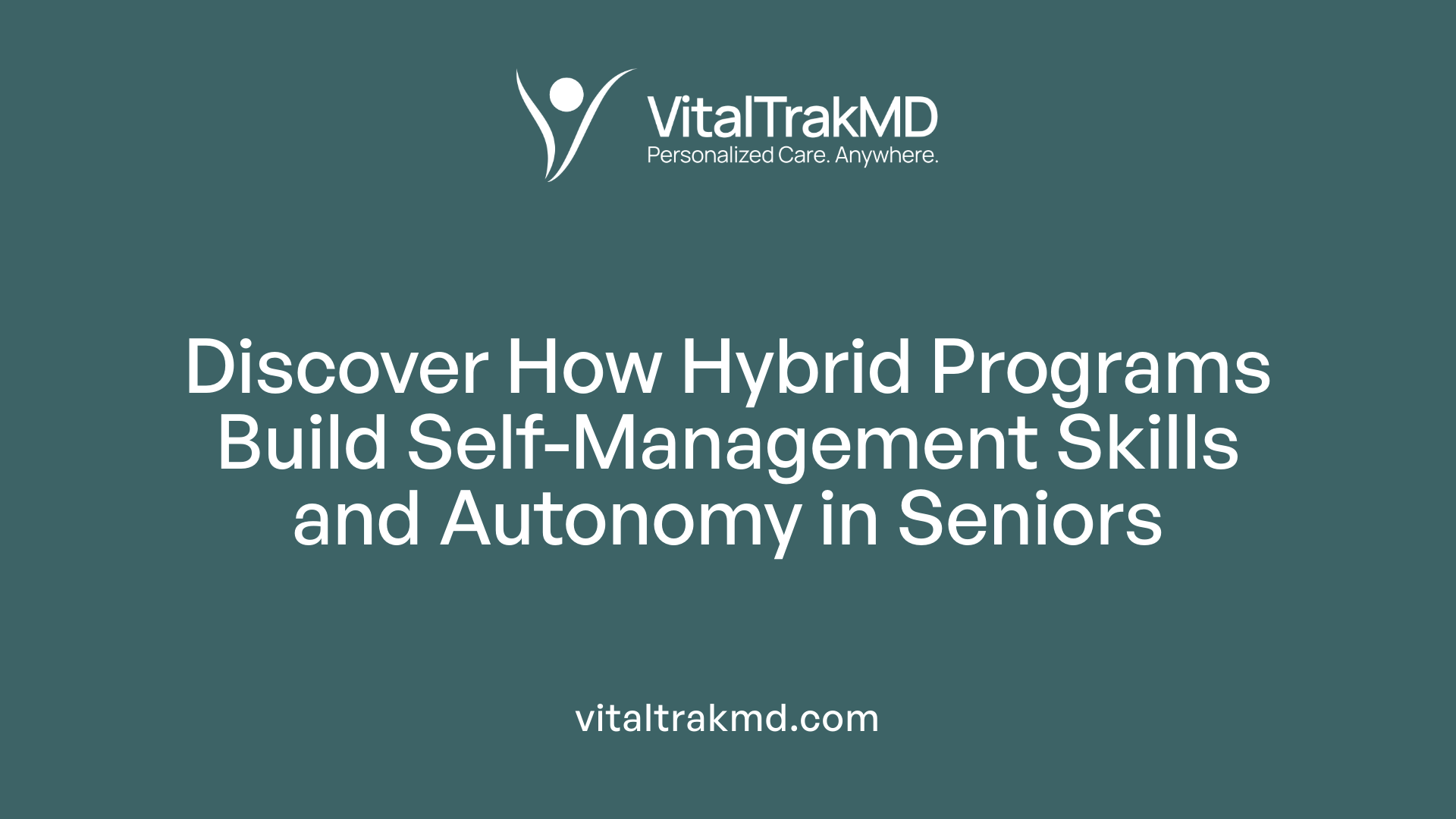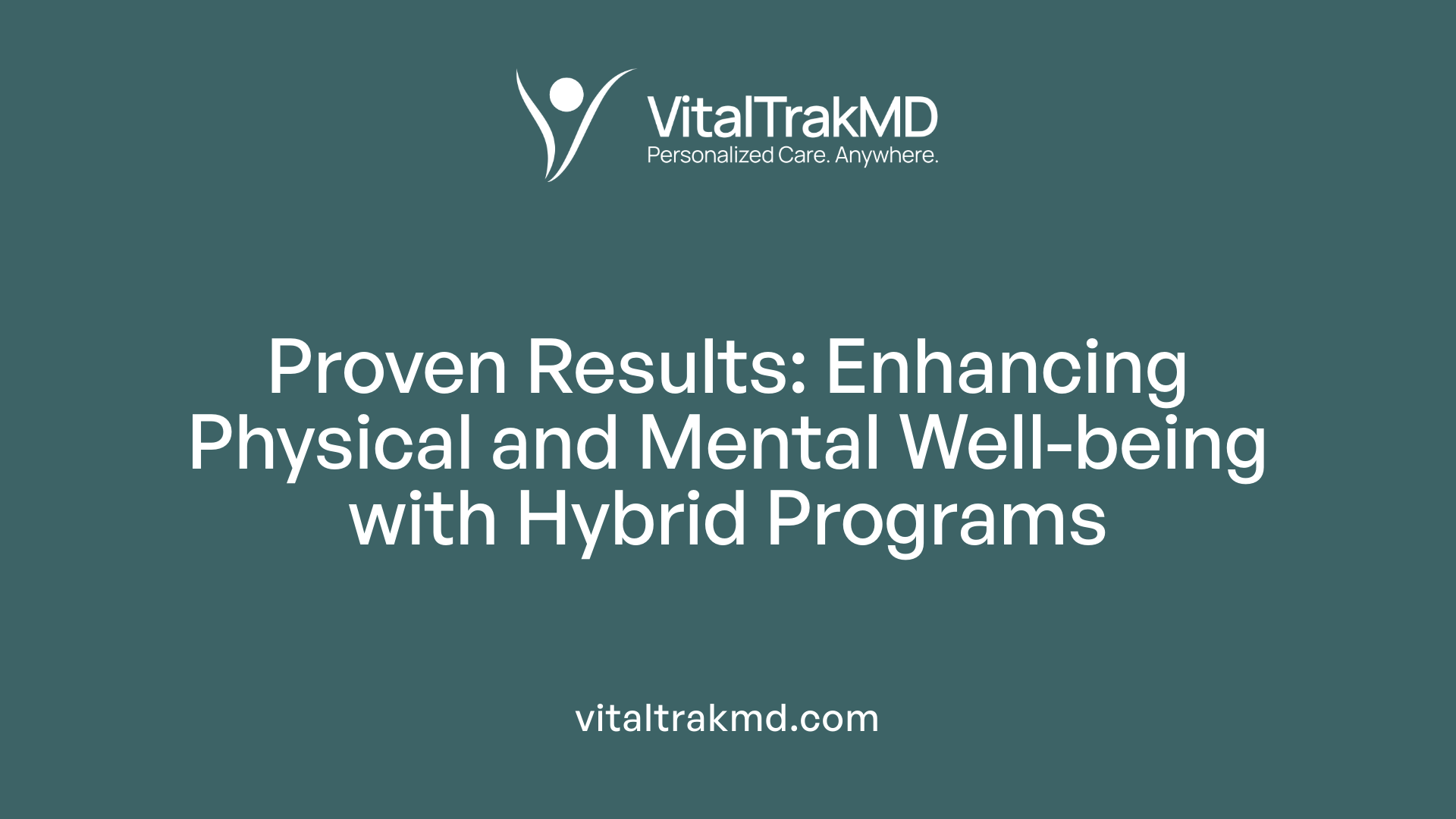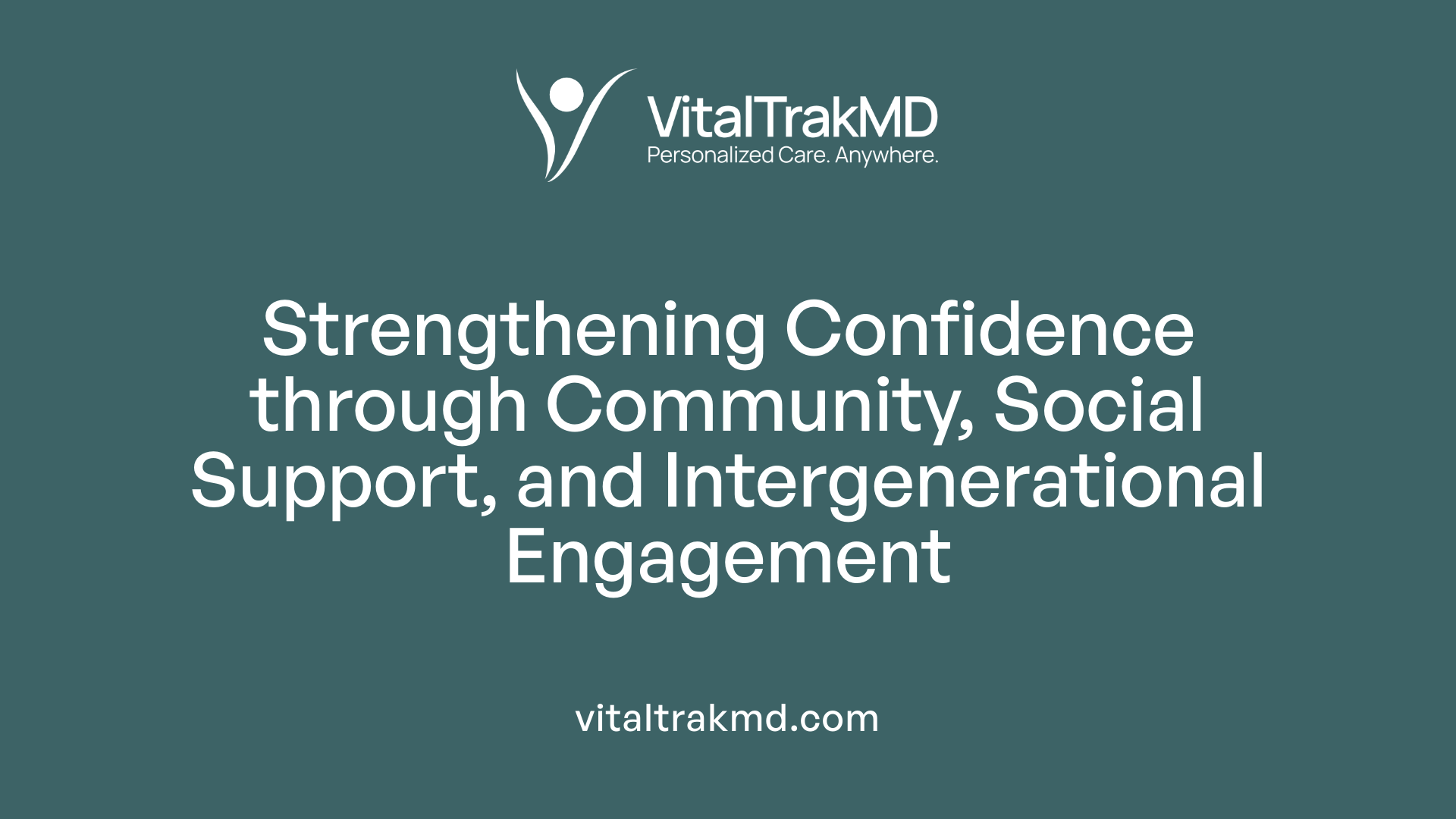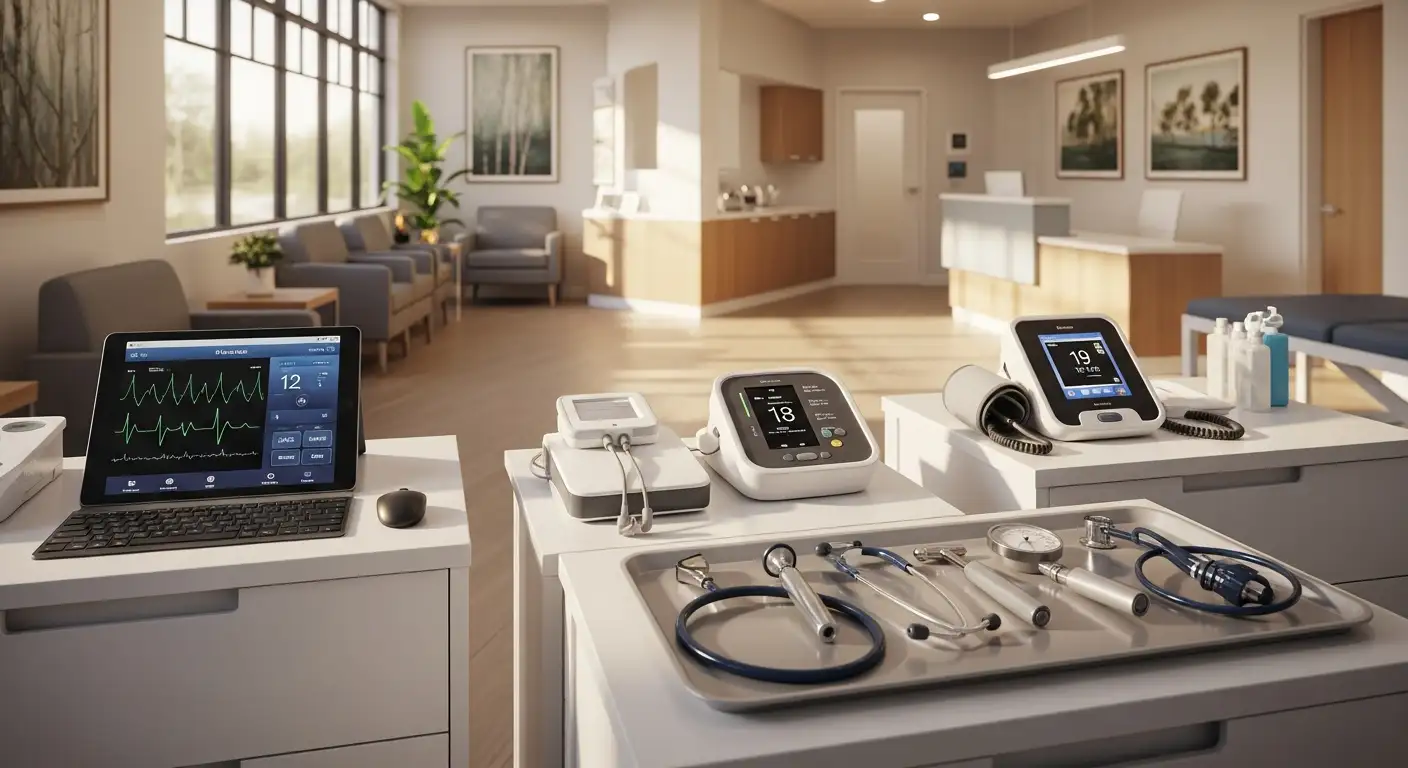Why Hybrid Programs Improve Senior Confidence in Managing Health

Building Confidence in Health Management with Innovative Approaches
As the aging population grows, empowering older adults to manage their health confidently has become a key focus for healthcare providers. Hybrid programs, which integrate in-person care with digital health technologies, show promising results in enhancing self-efficacy, improving physical fitness, and supporting holistic well-being among seniors. This article explores how these programs function, their evidence base, implementation strategies, and their significant impact on fostering independence and confidence in health management.
Benefits of Hybrid Programs in Enhancing Elder Confidence

What are the benefits of hybrid programs in improving senior confidence in managing health?
Hybrid health programs combine the advantages of traditional in-person care with advanced digital tools like telehealth, remote monitoring, and online resources. This integrated approach offers numerous benefits for older adults aiming to manage their health confidently.
One of the main advantages is accessibility. These programs eliminate barriers such as transportation issues, mobility challenges, and geographic distances, making it easier for seniors to engage with healthcare providers regularly. With options like virtual visits and remote check-ins, older adults can participate actively in their health management without leaving their homes.
Another benefit is the personalized and continuous support that hybrid programs provide. With dedicated nurse case managers, community workers, and digital tools tailored to individual needs, seniors receive ongoing guidance and education. This continuous interaction helps improve health literacy and boosts confidence in understanding and managing their health conditions.
Digital tools also foster a sense of independence. Participants learn to monitor symptoms, adhere to medication routines, and follow exercise or nutrition plans independently. This empowerment enhances self-efficacy – the belief in one’s ability to succeed.
Moreover, hybrid healthcare encourages regular communication and feedback, which builds trust between older adults and their healthcare team. When seniors feel supported and capable of controlling their health, their confidence in managing health matters significantly increases.
In essence, by integrating flexible access, personalized support, and digital empowerment, hybrid programs promote autonomy and improve overall health outcomes among older adults, helping them live healthier, more confident lives.
The Role of Digital Tools and Technologies

How do hybrid programs enhance health management confidence among older adults?
Hybrid healthcare programs utilize a variety of digital tools combined with in-person support to boost older adults' confidence in managing their health. These programs often include remote monitoring devices, telehealth services, and online educational resources that make health management more accessible.
Using virtual platforms such as Zoom or telehealth phone calls, seniors receive tailored health education and regular check-ins, which help them understand their conditions and develop self-care skills. Digital literacy initiatives are also integrated, empowering seniors to confidently navigate health apps and online resources.
Social engagement is a vital component of these programs. Virtual watch parties, online social groups, and intergenerational activities foster a sense of community and reduce isolation. Such interactions not only improve mental well-being but also reinforce motivation to follow health routines.
Goal-setting and self-monitoring tools enable seniors to track progress, observe positive changes, and feel more in control of their health. Support from interdisciplinary teams—including nurses, social workers, and community volunteers—further reinforces this confidence.
By addressing barriers such as mobility and geographical limitations, hybrid digital tools make health management less intimidating. The inclusion of technology-based support, goal-oriented activities, and social connectivity creates a comprehensive environment that enhances seniors’ ability to confidently manage their health, leading to improved quality of life and better outcomes.
| Aspect | Description | Additional Benefit |
|---|---|---|
| Remote Monitoring | Devices that track vital signs and activity levels | Helps detect issues early, promotes self-awareness |
| Telehealth Services | Virtual consultations with healthcare providers | Eliminates travel barriers, ensures timely advice |
| Online Education | Web-based resources and tutorials | Improves health literacy, self-efficacy |
| Social Engagement | Virtual group activities and intergenerational programs | Reduces loneliness, builds community |
Overall, the integration of these digital tools within hybrid programs equips older adults with the skills and confidence needed for effective health management, fostering independence and well-being.
Research Evidence Supporting Hybrid Health Interventions

How does a hybrid exercise program improve physical fitness in older adults?
Research shows that combining traditional exercises like Wu Qin Xi with strength and endurance workouts can significantly enhance physical fitness in older adults. In a 24-week randomized controlled study involving 181 frail seniors, participants experienced notable gains in measures such as 10-meter maximum walk speed and grip strength. These improvements reflect increased mobility and muscular strength, which are crucial for maintaining independence.
Can such programs reverse frailty?
Yes, evidence suggests they can. In the same study, 41.7% of frail participants reversed their frailty status after completing the hybrid exercise program. This reversal indicates that targeted physical activity can significantly augment health and resilience among vulnerable seniors, reducing their risk of health complications.
Do these interventions enhance quality of life and self-efficacy?
Beyond physical improvements, community-based programs aimed at self-care and health management have demonstrated positive effects on participants' self-efficacy and quality of life. Participants reported increased confidence in managing their health, along with improvements in overall well-being. The inclusion of personalized education and support from multidisciplinary teams contributed to these favorable outcomes.
What evidence supports the effectiveness of hybrid health interventions for seniors?
Multiple studies highlight that hybrid health approaches—integrating in-person care, telehealth, and digital tools—are highly effective. For example, programs using remote monitoring, virtual activities, and digital coaching have boosted physical activity, improved mental health, and increased engagement in health behaviors. Community partnerships and innovative delivery platforms like Zoom and AI coaching have enhanced accessibility and adherence, even amid challenges such as staffing shortages and pandemic-related restrictions.
| Aspect | Outcomes | Details |
|---|---|---|
| Physical fitness | Improved gait speed, grip strength | Noted in clinical trials with older adults |
| Frailty reversal | 41.7% reversed | Frail individuals regained robustness |
| Quality of life | Increased self-efficacy | Gains in daily function and confidence |
| Engagement | High satisfaction | Strong bonds with human and digital coaches |
How do digital tools and community partnerships support these interventions?
Digital tools like telehealth, remote monitoring, and virtual groups make exercise and health education more accessible, especially for those with mobility or transportation issues. Community centers and academic collaborations foster social engagement and sustain program delivery, which are vital for long-term success. These integrated efforts promote independence and social connection, improving overall health outcomes among older adults.
Implementation Strategies and Considerations
What are the key implementation considerations for hybrid healthcare models supporting senior health management?
Successful integration of hybrid healthcare models for older adults hinges on several critical factors. First, ensuring technology accessibility and ease of use is paramount. As many seniors may face unfamiliarity with digital tools, interfaces should be simple, intuitive, and include training sessions tailored for older users. Bridging the digital divide is essential, especially for those in remote or underserved areas.
Integration with existing healthcare systems is another vital aspect. This involves establishing seamless communication channels between virtual platforms and traditional in-person care, allowing healthcare providers to coordinate effectively. Synchronizing electronic health records and scheduling systems helps maintain continuity and comprehensive care.
A multidisciplinary team approach is fundamental. Teams composed of nurses, social workers, community health workers, traditional medicine practitioners, and general practitioners can deliver personalized, holistic support. Such teams facilitate comprehensive health education, self-monitoring training, and emotional support.
Training healthcare providers and caregivers to operate telehealth tools, remote monitoring devices, and virtual communication platforms ensures smooth service delivery. Ongoing professional development fosters confidence and proficiency in utilizing emerging digital health technologies.
To validate the effectiveness and sustainability of these models, continuous evaluation is necessary. Monitoring key metrics—such as readmission rates, functional improvements, and patient satisfaction—guides iterative refinements. Employing behavioral theories like self-efficacy and social interdependence can enhance patient engagement and adherence.
In conclusion, thoughtful implementation—centered on accessibility, integration, teamwork, training, and evaluation—can significantly improve health outcomes for older adults through hybrid healthcare models.
Impact of Hybrid Exercise and Health Programs on Physical and Mental Well-Being
What is the impact of hybrid exercise and health programs on physical fitness and overall well-being of older adults?
Hybrid exercise and health programs significantly improve the physical health of older adults, with notable results observed after just 24 weeks of intervention. In a study with 181 frail seniors, participation in these programs led to core physical gains such as faster walking speeds and increased grip strength. Impressively, nearly 42% of frail participants experienced a reversal of their frailty status, highlighting the potential for these interventions to restore functional capacity in older adults.
These programs typically combine traditional exercise forms like Wu Qin Xi, which is rooted in Chinese movement therapy, with strength and endurance training. This mix allows for comprehensive physical improvements, addressing multiple facets of health simultaneously. Such multimodal approaches help older adults maintain independence longer, reduce falls, and improve balance.
Beyond physical benefits, hybrid programs enhance mental health by fostering confidence and social interaction. Technologies like digital coaching, telehealth, and virtual activity platforms increase accessibility, making it easier for seniors in remote or underserved areas to participate.
The holistic nature of these programs, incorporating behavioral and social support alongside physical activity, supports quality of life and promotes mental well-being. Innovations like community-based health-social partnerships not only improve physical function but also boost self-efficacy, reducing feelings of isolation and encouraging active aging.
In summary, hybrid exercise and health programs are proven to be effective tools in promoting healthy aging. They help reverse frailty, improve physical capacity, support mental health, and enhance overall well-being, ultimately contributing to a higher quality of life for older populations.
Challenges and Efficacy Considerations
What are the challenges and considerations regarding the efficacy of hybrid health programs for older populations?
Implementing hybrid health programs for older adults offers promising benefits, but it also comes with significant challenges. One primary concern is the digital divide, where some seniors lack access to necessary technology such as smartphones, tablets, or reliable internet, especially in rural or underserved areas. This lack of access can prevent full participation and reduce the programs' overall impact.
Physical and cognitive limitations also pose barriers. Many older adults experience sensory impairments, like hearing or sight loss, or cognitive issues, that can make navigating digital platforms difficult without proper support. Low digital literacy further compounds these issues, making initial engagement and ongoing use more challenging.
To address these disparities, strategies such as providing user-friendly platforms, tailored training, and involving caregivers are essential. These measures help ensure that technology is accessible and usable for all participants.
Balancing remote and in-person care is another critical consideration. While telehealth extends reach and offers flexibility, some older adults still prefer face-to-face interactions for personalized care and social connection. Finding the right mix helps maintain high-quality services and caters to diverse preferences.
Finally, safeguarding privacy and security during digital interactions is vital. Building trust through secure systems and involving elders in the design process can increase acceptance and adherence. Tackling these challenges proactively enhances the efficacy and sustainability of hybrid health programs for older populations.
Community and Social Support’s Role in Confidence Building

How do community-based and social interventions within hybrid programs contribute to boosting senior confidence?
Community and social support are crucial elements in enhancing the confidence of older adults participating in hybrid programs. These interventions foster social engagement and create opportunities for peer interaction, which can significantly reduce feelings of loneliness and social isolation often experienced by seniors. When older adults are engaged in social activities—both online and in person—they develop a stronger sense of belonging and perceived social support, which strengthens their self-esteem.
Hybrid programs leverage technology and virtual platforms to make participation more flexible and accessible. Virtual activities like group discussions, cultural events, and watch parties enable older adults to stay connected without physical mobility constraints. These familiar and enjoyable experiences help increase comfort levels and encourage active participation.
Intergenerational activities further boost confidence by fostering mutual understanding and learning. Collaborations with young community members, such as students or intergenerational groups, introduce seniors to new skills and perspectives, promoting a sense of achievement and independence.
To sustain ongoing engagement, these programs often include technical support, guiding older adults in navigating digital tools, and providing accessible educational materials. This ongoing assistance helps build digital literacy and confidence in using technology, which can translate into better management of health information and daily tasks.
In summary, community and social interventions integrate familiar interests, peer support, and intergenerational collaboration to create empowering environments that enhance older adults’ confidence. The blend of in-person and virtual participation, supported by technical assistance, helps seniors develop a sense of competence and independence, contributing significantly to their overall well-being.
Future Directions and Innovations in Hybrid Senior Care
What are the future directions for hybrid programs supporting senior health?
Hybrid care models for older adults are poised to evolve significantly with the integration of emerging technologies and innovative approaches. Advances in artificial intelligence (AI) and machine learning are expected to play a central role. These tools can analyze vast amounts of health data to create personalized care pathways, adjusting interventions based on individual health status, preferences, and progress.
Innovations like advanced motion capture technology can enhance physical therapy and movement analysis remotely, providing more precise feedback and rehabilitation support. This helps tailor exercise programs such as Wu Qin Xi, strength, and endurance exercises to each person's needs, boosting their effectiveness.
Intergenerational collaboration models are gaining attention as a way to improve engagement and combat stereotypes about aging. Young people, especially those skilled in digital technologies, can assist older adults with tech use, participate in virtual activities, and foster meaningful social connections.
Research remains vital to refine these approaches. Future studies will focus on understanding how best to implement hybrid programs at scale, ensuring they are effective, accessible, and sustainable. Policymakers are encouraged to develop frameworks that support widespread adoption while addressing digital disparities.
Efforts will also target increasing digital literacy among seniors and expanding access in remote or underserved areas. The goal is to create an integrated healthcare ecosystem that is engaging, equitable, and responsive to the diverse needs of our aging population.
In summary, the future of hybrid senior care centers on technological innovation, stronger intergenerational links, rigorous research, and supportive policies, all aimed at enriching health, independence, and quality of life for older adults.
Conclusion: Embracing Hybrid Healthcare for a Confident Aging Population
Hybrid healthcare programs offer a promising avenue to boost confidence among older adults in managing their health. By blending traditional in-person care with innovative digital tools like telehealth, remote monitoring, and virtual activities, these programs foster greater independence and social engagement. Participants can access personalized health education, track their health metrics, and remain connected with healthcare providers from the comfort of their homes.
Implementing such programs effectively requires overcoming challenges like digital literacy gaps and ensuring equitable access. Collaborations with community centers, academic institutions, and intergenerational partners help address these barriers and tailor interventions to diverse needs.
Looking forward, technological advances in artificial intelligence and integrated health services are poised to further improve outcomes. They will enable even more personalized, accessible, and engaging care experiences. Ultimately, embracing hybrid healthcare can promote a healthier, more resilient, and self-assured aging population, transforming senior care into a confident and empowering journey.
Final Thoughts: Empowering Seniors in Their Health Journey
As hybrid healthcare models continue to evolve, their role in fostering confidence among older adults becomes increasingly vital. These programs not only address physical health needs but also promote mental, emotional, and social well-being, creating a holistic approach to aging. The integration of technology, community support, and personalized care strategies ensures that seniors remain active, engaged, and confident in their ability to manage their health independently. Overcoming barriers through inclusive design and policy support will be critical to expanding the reach and impact of these innovative models. Embracing hybrid care paves the way for healthier, more autonomous aging populations, where confidence and quality of life go hand in hand.
References
- Hybrid Exercise Program Enhances Physical Fitness and ...
- What Is Hybrid Healthcare? | Tools, Benefits, and Solutions
- Hybrid Programming Supports Older Adults and Caregivers
- A community-based health–social partnership program for ...
- Systematic review exploring human, AI, and hybrid health ...
- 4 Benefits of Telemedicine for Seniors
- Comparing In-Person Only, Telemedicine Only, and Hybrid ...
- What Is Hybrid Healthcare? | Tools, Benefits, and Solutions
Recent articles
Want to Feel Better and Live Healthier?
Join hundreds of patients taking control of their health with personalized care that fits their life – not the other way around.
Rated 4.8/5 by 32+ customers







